本帖最后由 cools0812 于 2019-2-20 18:22 编辑
https://forum.paradoxplaza.com/f ... ruary-2019.1153355/
牧游社 牧有汉化翻译
Imperator - Development Diary - 18th of February 2019 Trin Tragula, Imperator
Hello and welcome to another Development Diary for Imperator:Rome! 大家吼啊,欢迎来到新一篇帝皇:罗马的开发日志!
Today we will be looking at Tribes once again, this time tribal migration in particular. For a repetition on how tribal politics and Centralization works see this previous Development Diary. 今天我们将再次关注部落的内容,这次的重点是部落迁徙Tribal migration。若你想回顾部落政治和中央集权度的工作机制,请看之前的开发日志。
One thing that stands out about many of the tribal societies we represent in Imperator is that they would at times migrate quite far away, settle in completely new locations and build themselves a new society elsewhere. In some cases this was a slow process where the influence of one tribal entity spread to nearby areas, but in others it was a more drastic movement of people from one place to another. 在帝皇:罗马的世界中,我们为众多部落社会所描绘的一个共同特点是——他们偶尔会迁徙相当远的距离,之后定居在全新的地方并在那里建立新的社会。在有些记载中,一个部落的影响力扩散到附近区域的过程相当之缓慢,而在另外一些记载中,部落人口从一处迁移到另一处的进程则更加激烈。
One such example is the creation of the Galatian states in Anatolia, new realms founded by Celts from the European mainland in Central Anatolia. Other examples abound in Germania and even the Pontic Steppes. 在安纳托利亚成立的加拉太人Galatian国家是一个典型案例,这是由从欧洲内陆迁移而来的凯尔特人在安纳托利亚中部建立的新国家。另外一些例子集中在日耳曼尼亚,甚至是本都大草原。
Migration 迁徙
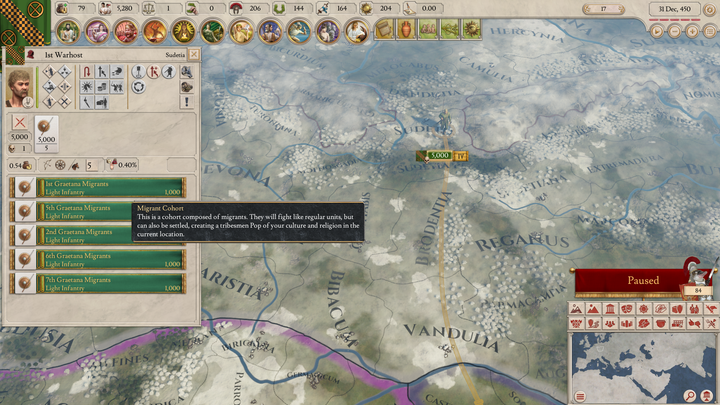
In the game all Tribal Chiefdoms will have the ability to migrate, and all Tribal states can become a Tribal Chiefdom if they reach a sufficient degree of decentralization. 在游戏中,所有的部落酋邦Tribal Chiefdom都拥有迁徙的能力,同时所有部落制的国家只要中央集权度达到一定的负值,就可以变为部落酋邦。
Migration can be initiated in any city that has at least 3 pops, for a base cost of 100 Oratory power (reduced by negative Centralization), by clicking on the Migrate button in the city section of the province interface. 任何一个有至少3人口的城市都可以开始迁徙,基础消耗是100点雄辩点数(负集权度越高,花费越低),点击省份界面的城市分区里的迁徙按钮就可以了。
Migrating will turn up to 20 of the pops in the city into Light Infantry. This creates an army that can move around like any army, except it does not require military access to cross foreign lands. All types of pops can be used to create a Migration cohort but once settled (see below) always turn into Tribesmen. To migrate is to let go of any old specialized roles they may have had in their original location. 迁徙会将城市内至多20个人口变为轻步兵部队。此举产生的部队可以像其他部队一样移动,不过他们进入外国领土时不需要军事通行权。所有的人口种类都可以被创建为迁徙部队,但是当他们定居下来后(详见下文)就会变回部落民。迁徙会让所涉及的人口放弃在原居住地的所有特定角色。
Even if a country loses its last city it still remains playable as long as the Migration units remain, meaning you can quite literally uproot your entire society and resettle somewhere else. 即使一个国家丢掉了最后一座城市,只要该国的迁徙部队还存活就可以继续进行游戏,这意味着你可以把你的整个社会连根拔起(字面意思上),然后搬到别的地方去。
Settling 定居 
Any army that has more Migration cohorts than there are pops in its current location can settle in that location. This will turn all Migration units into Tribesmen of your culture and religion and settle them in this city, taking ownership of it, even if it was owned by someone else beforehand. In order to be able to settle the location must also either be uncolonized or under your control in a war. 只要迁徙部队中的步兵大队数量比本地现有人口更多,那么他们就可以定居在此地。这样会将所有的迁徙部队变成属于你文化和宗教的部落民,控制该处城市并定居于此,即使这个城市此前为他人所有。为了完成在这里的定居,目标地区必须未被殖民或者在一场战争中处于你的控制之下。
Using this tribes can quickly establish themselves in a new region, creating a new life far from where they started. Much like colonization settling does not turn locals into your culture or religion, which means this newly created settlement may have to deal with some unhappy pops among its locals. 用这种方法,部落可以迅速地在远离故土的全新地区创造新生活。和殖民Colonization相似,定居不会把本地人口变为你的文化或宗教,这意味着新创建的定居点可能得面对原住民人口的不满情绪。
Pillaging 劫掠 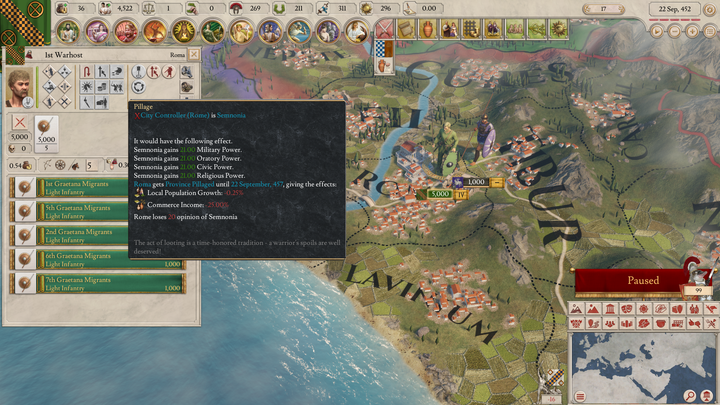
An army containing Migration units can also use the Pillage unit ability when in foreign owned cities. This will give the city a 5 year penalty to population growth and commerce and will give direct additions of power based on the number of pops living in the city and its current Civilization level. 包含迁徙部队的军队,在外国控制的城市还可以使用劫掠的部队能力。这会给城市带来5年的人力增长和贸易惩罚,同时会基于城市人口数量和其当前的文明等级给予劫掠者直接的点数奖励。
A city cannot be pillaged again as long as the penalty has worn out. 惩罚持续时间到期前,城市不能被再次劫掠。
Germania 日耳曼尼亚 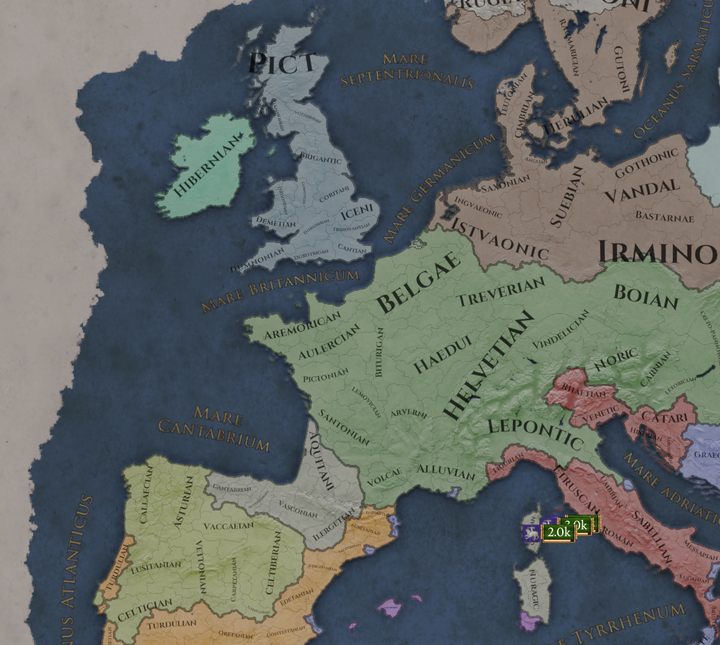 Screenshot showing where the Germanic cultures can be found currently.
截图显示目前日耳曼文化存在于哪些地区。
And with that we move on to one part of the map where this mechanic is very readily available. In our start of 450 AUC all countries in Northern Germania are Tribal Chiefdoms, and they all start at -50% Centralization or less, meaning that Migration is not just available, it is also quite efficient. 讲完了迁徙内容后,让我们来翻开地图,讲讲最容易用到这个机制的那一部分地区。在游戏的开局日期,建城后450年时,北日耳曼尼亚地区的所有国家都是部落酋邦,开局时它们的集权度都在-50%甚至更低,这意味着对它们来说迁徙不仅仅是可用机制,更可以说是相当有效的手段。
From a historical standpoint Germania in 450 AUC/304 BCE is one of the most poorly documented places we have on the map. While larger cultures and trends have been observed, and while we know a fair bit about what was going on later in time, we cannot know for sure about any details at our start. For this reason this region is among the more speculative included in the game. For that matter deciding what should start settled and owned by a "country" and what should be populated but unclaimed at our start is not easy. We have arrived at what we hope is a balance that will best facilitate a historical feel to the area, one where the abilities you have in the game to migrate and colonize can be of good use, while still allowing the more noteworthy tribal entities that existed to be playable. 从历史学角度来看,建城后450年/公元前304年时,日耳曼尼亚是我们地图上文献记载最少的区域之一。虽然我们已经能观察出大体的文化与发展趋势,同时我们对之后历史上发生的事情也有所了解,但是我们对游戏开局时日耳曼尼亚地区的细节依然完全不确定。因此这里是游戏中最靠我们的推测来制作的区域之一。这就导致我们很难决定某个区域在开始时是该由哪个“国家”所定居及拥有,或是虽然有人居住但并未有归属。我们希望达到的平衡效果是给该地区增添历史的氛围,在游戏中玩家可以充分利用迁徙和殖民的能力,同时我们又可以做出更多值得关注的部落实体以供游玩。
Like in tribal regions elsewhere the Germanian tribes will have access to formable countries such as Suebia or Saxonia. 如同其他部落地区一样,日耳曼尼亚的部落可以创建苏维比亚Suebia(即今施瓦本地区)以及萨克森尼亚Saxonia这样的可成立国家。
Western Germania 西日耳曼尼亚 
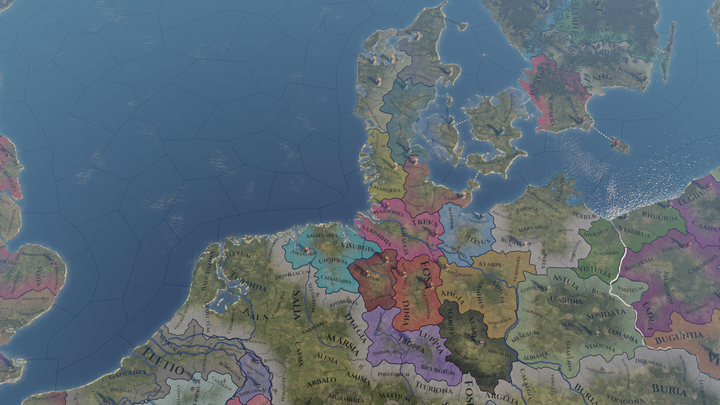
The part of northern Germania that is closest to Gaul, often called the Jastorf culture area. In 450 AUC this region is inhabited by a wide variety of tribal states, some will later be found in far from these locations while others will remain familiar to this setting. Had the writings of the explorer Pythias of Massilia survived we might have known more but all we can say with certainty is the start of the game this is a dynamic region with a great variety of outcomes. 这是靠近高卢的北日耳曼尼亚部分,一般被称作亚斯托夫Jastorf文化区。在建城后450年时,这片区域中被相当多的部落国家占据着,其中的一些部落之后将在远离该区域的地区被发现,另一些则将仍旧生活在这里。有赖于探险家马塞里亚的皮西亚斯Pythias of Massilia现仍存世的著作,我们可以就此知晓更多的信息(尽管未掌握全貌),我们依然可以确定的是在游戏开局时,这里将是一片活跃的地区,潜藏着极为丰富的可能性。

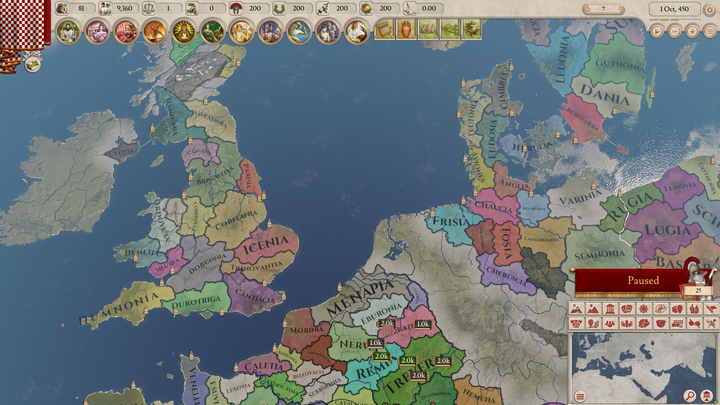
Starting Countries
初始国家
Frisia: Medium Sized Tribal Chiefdom on the western edge of the Germanic region. Would eventually push south and west, where they came in contact with the Roman Empire.
弗里西亚:日耳曼尼亚地区西部边缘的中等大小的部落酋邦。它将最终向西部和南部推进,在那里与罗马帝国建立接触。
Angrivaria: Small Tribal Chiefdom surrounded by stronger neighbors. Would remain active in the area into imperial era.
盎格里瓦里亚:强邻环绕的小型部落酋邦。在该地区纳入帝国统治后将依旧保持活跃。
Cheruscia: Tribal Chiefdom on the southern edge of this region. Perhaps most known for, along with neighboring tribes, defeating the Roman commander Varus in the Teutoburg forest in 9 AD, shortly after the end of this game. In 304 BCE nothing of that is predetermined however and this is just one of the tribes contesting this region.
切勒斯西亚:该地区南部边缘的部落酋邦。其最为闻名的事迹大概是和临近的部落一起,于公元9年在条顿堡森林击败了罗马统帅瓦卢斯,此事会发生在游戏结束时间稍后。不过,在公元前304年,这一切都尚未预定,它也只是该区域内竞逐的一个普通部落而已。
Chaucia: Germanic Tribal Chiefdom in the region between the Ems and Elbe. Like the Cheruscia they are largely known for things that would transpire long after the start of our game.
肖西亚:埃姆斯河与易北河之间的日耳曼部落酋邦。和切勒斯西亚一样,它因条顿森林之战这一远晚于游戏开局时间的历史事件而著名。
Fosia: Smaller and slightly poorer neighbors of Cheruscia.
弗西亚:与切勒斯西亚相比略小且穷的邻居。
Marcommania: Strong Tribal Chiefdom that would in time migrate south to modern Bohemia.
马科蒙尼亚:强大的部落酋邦,将南迁至今波希米亚地区。
Langobardia: Tribal chiefdom controlling part of the Elbe. Their later day relatives would migrate far to the south.
兰格巴迪亚:控制了部分易北河的部落酋邦。稍晚些时候他们的亲眷将远迁南方。
Reudigna: Small tribal chiefdom just south of the Jutland peninsula.
鲁迪格尼亚:位于日德兰半岛正南方的小型部落酋邦。
Anglia: Small Tribal chiefdom south of the Jutland Peninsula. Would many centuries later settle in the British Isles.
盎格利亚:日德兰半岛南部的小型部落酋邦,将在数个世纪之后迁居不列颠诸岛。
Aviones: Another Jutlandic tribe, in modern North Frisia.
阿维恩斯:另一个日德兰半岛的部落,位于现今北弗里西亚地区。
Eudosia: Tribal chiefdom, probably the sma people that is later simply known as the Jutes.
尤多西亚:一个部落酋邦,可能就是后来被称为朱特人Jutes的人群。(译注:加入了盎格鲁撒克逊人入侵不列颠行动的,来自日德兰半岛的日耳曼人中的一支)
Teutonia: Tribal chiefdom in northern Jutland. Came to clash with the Roman Republic, along with Cimbri in the Danubian river area and even as far south as Italy.
条顿尼亚:日德兰半岛北部的部落酋邦。与多瑙河的辛布里人一同与罗马帝国发生过冲突,其规模甚至波及到了意大利。
Cimbria: Like the Teutons the Cimbri fought the Romans around 100 BCE, but at our start they are one of the many Jutlandic tribes, far away from Rome and any other mediterranean states.
辛布里亚:和条顿人一样,于公元前100年左右辛布里人也与罗马人交战。不过在游戏开局时,它也只是日德兰半岛诸部落中普通的一个,远离罗马和其他地中海区域国家。
Baltic Germania 波罗的海日耳曼尼亚 
Moving east along the baltic we reach the eastern end of the Jastorf area as well as a number of other cultures into one of the parts of Germania that is the furthest away from the Mediterranean. Hence little is actually known about local politics. Like the Germanic region to its west this is a region divided under a variety of tribes, some which would carry the embryo to later more famous groups such as the Vandals, Goths or Suebi. This region is remarkable for its high availability of Amber, that would later spread. 沿着波罗的海向东,我们抵达了亚斯托夫文化区和其他一些种类文化的东部边缘,进入距离地中海最远的日耳曼尼亚区域之一。因此对于当时当地的地方政治格局而言,我们所能确知的内容极为有限。像它西部的日耳曼尼亚地区一样,这里也是由不同部落分割控制的地区,其中的一些部落将发展为日后更为著名的部落,例如汪达尔人Vandals、哥特人Goths或苏维比人Suebi。该区域以拥有大量易开采的琥珀而著名,它将在随后远播。 
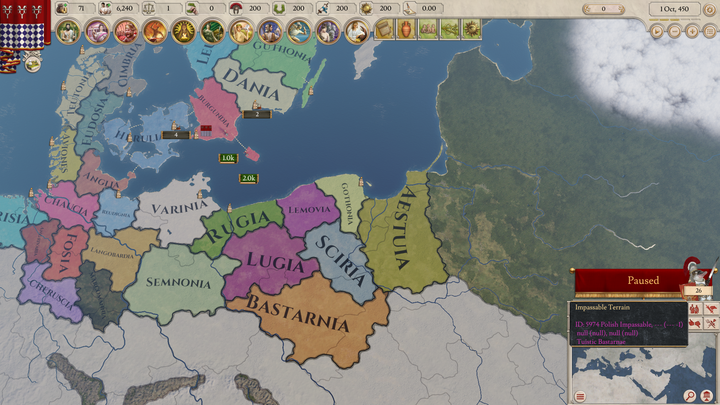
Starting Countries
初始国家
Varinia: Staunch Germanic tribe in modern Mecklenburg and Pomerania.
瓦里尼亚:位于现今梅克伦堡和波美拉尼亚的稳定的日耳曼部落。
Semnonia: Suebi Tribal Chiefdom in the central Germanic region.
塞诺尼亚:位于日耳曼尼亚地区中心的苏维比人部落酋邦。
Rugia: Small tribal chiefdom with supposed roots in northern Scandinavia.
鲁吉亚:可能起源于斯堪的纳维亚北部的小型部落酋邦。
Lugia: The Lugi are often identified with the later Vandals. In 450 AUC they are a moderately powerful tribal chiefdom in northern Germania.
洛吉亚:洛吉人一般被认为是日后的汪达尔人的祖先。在罗马建城后450年时,他们是北日耳曼尼亚地区一个普通的强大部落酋邦。
Lemovia: Small tribal chiefdom with close ties with Lugia and Rugia.
莱莫维亚:与鲁吉亚和洛吉亚关系密切的小型部落酋邦。
Bastarnia: Powerful tribal chiefdom in modern day Poland. Would in time migrate south and come into conflict with the Roman Republic in the Carpathian region.
巴斯塔尼亚:位于现今波兰地区的强大部落酋邦。他们将进行南迁,并在喀尔巴阡地区和罗马帝国产生冲突。
Gothonia: Small tribal chiefdom in modern Pomerelia. One of the possible ancestors of the in the future so famous Goths.
哥特尼亚:位于现今波美拉尼亚地区的小型部落酋邦。未来著名的哥特人的可能祖先之一。
Sciria: Small Tribal Chiefdom by the Vistula river.
萨瑞亚:维斯瓦河畔的小型部落酋邦。
Aestuia: Baltic tribal chiefdom on the eastern side of the Vistula, and the only Baltic culture and religion playable country at the start of the game.
埃斯图亚:维斯瓦河东岸的波罗的海部落酋邦,游戏开局时唯一的采用波罗的海文化和宗教的可玩国家
翻译:一个幽灵 安然 校对:万豪顿 三等文官猹中堂
|